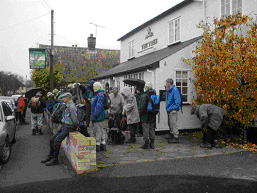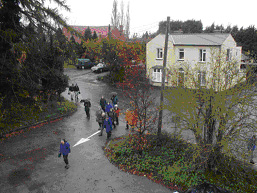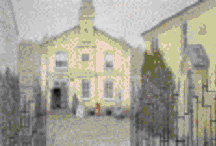** Please note that this is an archive of the CANTAB publication and contains out-of-date information **
CANTAB RAMBLER
Why not Sawston?
Cantab Rambler goes back to 1999, and a majority of issues include a “Parish of the Month”, as I have been told this is a popular feature.
So why not Sawston – the biggest village in terms of population (but not, in land area, the biggest parish) in South Cambs? It is because I have been daunted by the task of describing the many inner village paths through the housing, and partly because I felt that many readers will know Sawston very well already. However, I hope the following may be of interest, and contain something new for you.
Janet Moreton
N.B. You can look up a previous “parish of the month” under cantab-rambler, on Cambridge RA Group’s website,
Cambridgeramblers.org/cantab-rambler/
Parish of the Month – Sawston
Sawston is quite a small parish of 770 ha. Most of the parish is situated on fairly flat chalk soils to the east of the bypass, which separates it from its water meadows by the R Cam, and Whittlesford beyond. The village, however, is the largest old-established parish in South Cambs [Cambourne looks set to have a population of around 10 000, but it does comprise 3 villages!], with a shopping centre and facilities sufficiently large and varied to accord it the status of a small town.
Like most of the villages of the Cam valley, there are traces of prehistoric settlement. A Neolithic flint axe was found S of the village, and signs of Neolithic tool production were found on the site of the old vicarage. At least 10 ring ditches, former Bronze Age barrows, are grouped around a former trackway, and a Bronze Age hoard (axes and spears) was found on the Icknield Way. Borough Hill Iron Age fort was located on the W side of the railway, near the present Spicers Works (ca TL472494, not accessible).
The Romans left few traces here. The parish was settled by the Saxons in the C7th, when agricultural patterns were established. An Anglo Saxon burial was found in 1816, when workmen dug gravel from Huckeridge Hill, ca. TL 481503 on the road to Cambridge, finding a sword, a bronze bowl and snake’s head buckle. An Anglo Saxon mill existed at Dernford.
In early times, the places where the river could be forded gave rise to scattered settlements along these routes. The manors of Dernford, Pyratts (on the site of Sawston Hall), and Huntingdon are recorded throughout the Middle Ages. Later in the Middle Ages, the N-S route, on the road between Cambridge and Royston became more important than the E-W routes, with the village cross marking the junction with Church Lane, at TL487492. Linear development occurred along the High Street, consolidated in the C13th, when Pirot, the lord of the manor, planned a village extension in the direction of Cambridge.
As early as C17th, paper making started at Dernford Mill, although a mill had been present here since 956. In the C19th, Towgood had a paper mill, and built homes for his workers. Spicer Brothers purchased the paper mill in 1917.
A Chamois leather works at TL 486489 was established by Hutchings & Harding in the. mid C18th, with later premises dating from the mid C19th. T S Evans of Old Yard Leather Works developed The Spike for housing at the S end of the village. Crampton’s Mineral Waters was another large employer. Thus, by the mid C19th, aided by the coming of the railway, and the introduction of steam power in the paper industry, Sawston was an industrial village, putting behind the poverty of the earlier part of the century, when at times up to a third of the population had been on poor relief following agricultural inclosure in 1802.
Domesday records 3 manors, and a population of 41. The census of 2011 recorded some 7145 residents.
Points of interest
The parish church of St Mary The Virgin is a Norman foundation, dating from the early C12th. Its tower is 600y old, and the nave arches are Norman and Early English. It is usually open.
Nearby are the locked gates of Sawston Hall, unfortunately not open to the public. The hall, the former seat of the Huddleston family for more than 400y, briefly sheltered Mary Tudor in 1553, but was burnt by the mob after her escape. Some of the original building remains. Stone from Cambridge Castle was used in the rebuilding, which is dated in the central quadrangle 1557 and 1584.
Notable old buildings in the village are C16th Ward’s House, and Huntingdon house (typical H-plan manor with cross-wings), and a manorial dovecote in Hammonds Rd.
Sites of Special Scientific Interest
One SSSI lies to the W of the bypass and up to the railway line, being one of few remaining areas of fen carr in the S of Cambridgeshire. The other is Sawston Hall meadows (both inaccessible).
Public Footpaths
Fp1 – Dernford Rd to Lt Shelford boundary
Fp2 – Cambridge Rd to Dernford Rd (fp1)
Fp3 – Hillside to Martindale Way
Fp4 – Baulks (High St) to Crampton Terrace
Fp5 – New Rd to The Baulks
Fp6 – Mill Lane to Common Lane
Fp7 – Mill Lane to join fp 6
Fp8 – The Bull, High St to Common Lane
Fp9 – High St to Whittlesford
Fp10- Catleys Walk, London Rd to fp9
Fp11- Babraham Rd to Church Lane
Fp12- Church Lane by Mile Path to Babraham
Fp13-The Green Rd to Sunderlands Corner
Fp14- Church Lane to Pampisford fp 2
Fp15- Mill Lane rail crossing to Whittlesford
Fp16 No 11 Church Lane to Churchfield Ave
Fp17- High St to Shingay Lane
Fp18- Chestnuts, Mill Lane to The Baulks
Fp19- Mill Lane to West Moor Ave.
Fp20- The Baulks from Crampton Terrace to Mill Lane (continues fp 4)
Fp21- Paddock Way to fp 11
A street plan is essential for following the inner-village paths. Without one, I have become misplaced on more than one occasion in the large housing estates!
Outline walks
Here are a few suggested walks, probably well known already to local readers, taking one outside the village envelope, and with ideas for further extension. They mostly involve a certain amount of road walking, and are thus more suitable for the muddy winter months, which commonly extend into April. I would suggest that an exploration of some of the inner village paths, using a good street plan, is also interesting and worthwhile.
A To Whittlesford & beyond 3, 6 or 10miles
From Sawston carpark (CP) TL 487494, go S down London Rd. Turn off R down signed fp 9, or shortly after along Catleys Walk (fp10). Cross the bypass and the railway, and enter Whittlesford past the Hamilton Kerr Institute (restorations for the Fitzwilliam museum). Cross the large rec towards Whittlesford Churchyard (approached via a residential road, to the R of the pavilion) to use Whittlesford fp 1, becoming Sawston fp15 over a footbridge, cross the railway on the road by Spicers barrier, and then the bypass. Find a “backs of gardens” route, fp 20, leading to the Baulks and so to High St and the CP. This route may readily be extended to include a walk around Whittlesford and the Moor (6 miles), or also paths to Thriplow (10 miles).
B To Dernford and Whittlesford 5 miles
This rather “roady” route takes in the historic Dernford Hamlet. From the CP walk NW up Huckeridge Hill along the footway of Cambridge Rd. Turn left on signed fp 2 (past a flock of sheep?) to the bypass. Cross with care and follow the signed path to Dernford, two arable fields to be negotiated en route. At Dernford House, the path is waymarked through the garden. The start of the continuing Lt Shelford fp 2 is sometimes very damp. Reach the road at Rectory Fm, and turn S on the road to Whittlesford, passing attractive lakes (but take care, no footway). It is a pity there is no route through Spicers land. At TL 466486, take the path SSW then SE through a pretty young plantation on access land in the centre of Whittlesford. On reaching the road, turn left and walk to Whittlesford Guildhall. A snicket at TL 473485 leads to Whittlesford church (usually open via door at rear, also WC). Return by the route described in Walk A.
C To Babraham, 4, 5 or 7miles
From the Sawston CP walk to the parish church, go down Church Lane, and follow “the green road” to across the rec. Cross Babraham Rd, turn R and take a signed path L, Babraham fp 11 to Rowley Lane. Turn R along the lane and follow it to the S end of Babraham. Return immediately on a new /footway cycleway (adjacent to Sawston Rd), or, from the road corner, take a crossfield path to join Sawston fp 12, Mile Rd. (4 miles)
However, from the wall at the S corner of Babraham, it may be desired to walk to the “George” PH for refreshments, and, on the return, visit the “Pocket Park” and the signed route to the Church, in a handsome rural position against the backdrop of Babraham Hall. (total 5 miles)
To extend this route yet further, continue on the path by the R Cam past Babraham Hall, and research buildings and across fields and tree belts, passing a turning R across a footbridge to a path to the A1307. However continue ahead to a substantial bridle bridge marking the next crossing of the Cam. Note the mounting blocks here, following the conversion of Rowley Lane to a bridleway. Turn round here, and walk back down Rowley Lane to join the return route. (total 7 miles)
D To Pampisford 4 miles
From Sawston CP, walk to the parish church, take Church Lane, and turn half right on fp 14, joining Pampisford fp 2 to Pampisford Wych. Go S down this road (no footway), and turn off R on a signed fp through Home Fm. In Pampisford, take a short cut across the rec and visit the church. Follow the road through the village, to the pub on the corner. Turn R along London Road, taking a detour, if desired, to the L, through the yard of the Black Bull, and continuing on fp 6 along the edge of a sports field, before turning R for High St. This walk is not readily extended, except by making various detours on Sawston inner-village paths.
East Anglian County Summits
Here is a suggested project for the Spring
Why not visit the East Anglian County Summits?
Cambridgeshire’s Top, at 146m, is located S of The Hall, Great Chishill, on Landranger 154, TL 427380. From the B1039, a track runs close to the site.
The Top for Essex, 140m is nearby, at TL 433362 in Great Chishill.
Norfolk’s County Top, 102m, is at the accessible Roman Camp, Landranger 133, TG 185415, near Sherringham.
Look for Suffolk’s Top, 128m, off the A143, at Depden, SE of Elm’s Farm. There is no trig point – a GPS might suggest the exact place, (Landranger 155, TL 786558).
Bedfordshire’s Top, 243m, is on the Dunstable Downs, about a mile out of Bedford off the B4541, Landranger 166, SP 008194.
Finally, the highest of them all, the Top for Hertfordshire, 244m is at SP 914091 on Landranger 165 off a minor road 0.5km W of Hastoe, in the Chilterns.
Data from “The County Tops”, Paddy Dillon, 1985.
Cambridge Weather 2015
The Botanic Gardens issued a report of last year’s weather, summarised below.
The year started with some instances of light snow, which quickly disappeared. Rainfall for March, April and June was below average, and there was evidence of the ground cracking on warm days in April. July was a month of extremes, when 35.0degC was recorded on 1 July, and storms brought 87.1mm rain overnight on 23 July, contributing to an unusually high month’s total of 153mm. Numbers of days of high winds occurred, which resulted in temporary closure of the garden. The year finished with a rainfall total of 556mm, almost exactly the average annual rainfall of 557mm.
Elsworth Footpath 2
Problems have arisen recently relating to path usage on and around Elsworth Footpath 2. The path is signed alongside the village school, TL 313637. It passes down a fenced passage, goes round the edge of a small field, over a couple of small bridges, and then goes generally NW towards Pitt Dene Farm. The problem is on this latter section. Walkers have used the available farm track, whereas in fact the right of way follows the field edge on the other side of the ditch, before lighting off across the fields near the site of some former pits. Fairly recently the landowner has taken steps to inhibit the use of the farm track. Do you know this path? Have you walked along the farm track, believing it to be a right of way? RA Cambridge Group have offered to help Elsworth Parish Council assemble some evidence of past usage. Please send any details to me,
Janet – roger.janet@outlook.com
The Bike-Bus Explorer, Cambridge to Gamlingay on Sundays
Just before going to press, I have heard a rumour that the Bike-Bus Explorer, mentioned in the last issue, is presently discontinued. Please check before making plans to use it.
Cantab Rambler by E-Mail & Post
Cantab usually appears some 4 times per annum.. A large number of you now receive Cantab by e-mail. By hand, 20p is appreciated towards the cost of paper and ink. If you would like to receive an issue by post, please send a large SAE. Offers of brief articles will be gratefully received.
This is a privately produced magazine, and the views expressed are solely those of the editor, or of the author of an individual item.
Janet Moreton 01223 356889
e-mail roger.janet@outlook.com
Cantab84 © Janet Moreton, 2016.




